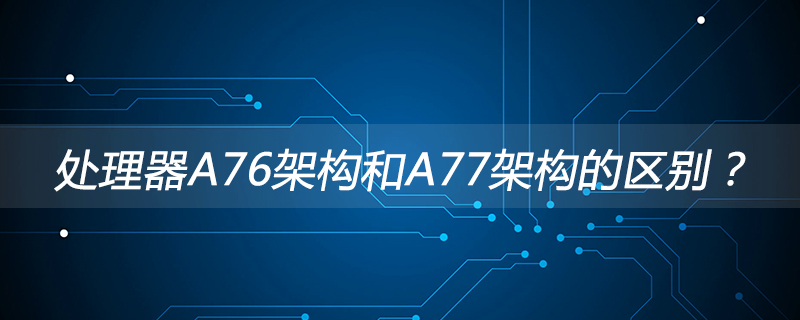What is the difference between processor A76 architecture and A77 architecture?

The difference between processor A76 architecture and A77 architecture
1. A77 has twice the branch predictor than A76;
2. A77 directly allows instructions to enter the CPU central renaming stage in the case of a cache hit, which reduces the length of the computing pipeline and improves efficiency by 30%.
Cortex-A77
From the perspective of product development generations, Cortex-A77 is the direct successor of Cortex-A76 , which means that the new architecture is basically the same as the previous generation product. ARM said that Cortex-A77 only needs to simply upgrade the SoC IP to deploy, and does not need to tear down and start from scratch.
Corresponding to the actual product, Cortex-A77, like Cortex-A76, still uses the ARMv8.2 CPU core and supports AArch32 and AArch64. In terms of multi-core design, Cortex-A77 still supports DSU (DynamIQ Shared Uint) to pair with the smaller Cortex-A55 unit. In terms of basic architectural configuration, Cortex-A77 still supports 64KB L1 instruction and data cache and 256KB or 512KB L2 cache.
Interestingly, ARM chose a smaller capacity solution for the L2 cache design of Cortex-A77, because its infrastructure-oriented Neoverse N1 processor architecture uses a 1MB L2 cache. This The architecture of the processor itself comes from Cortex-A76, which may mean that ARM has more unique ideas in processor configuration.
According to experience, as an evolution of the Cortex-A76 architecture, from a micro-architectural perspective, the performance improvement of Cortex-A77 should not be very large, and the same should be true from an absolute performance perspective. After all, the craftsmanship has not improved significantly at this time point. Most Cortex-A77 products will still use the 7nm process. ARM claims that the peak frequency of Cortex-A77 is the same as the previous generation Cortex-A76, which is 3GHz. If this is the case, the Cortex-A77 may not have much to offer.
But according to the roadmap released by ARM, Cortex-A77 can bring a 20% performance improvement compared to the previous generation products. Considering that it has not changed much in terms of process and frequency, this means that the architecture of Cortex-A77 will have obvious changes, and the IPC has been significantly improved. In fact, ARM has redesigned the Cortex-A77 architecture and introduced a large number of intelligent functions, thus bringing about a performance increase of up to 20% while the process and frequency remain unchanged.
Recommended tutorial: "PHP"
The above is the detailed content of What is the difference between processor A76 architecture and A77 architecture?. For more information, please follow other related articles on the PHP Chinese website!

Hot AI Tools

Undresser.AI Undress
AI-powered app for creating realistic nude photos

AI Clothes Remover
Online AI tool for removing clothes from photos.

Undress AI Tool
Undress images for free

Clothoff.io
AI clothes remover

AI Hentai Generator
Generate AI Hentai for free.

Hot Article

Hot Tools

Notepad++7.3.1
Easy-to-use and free code editor

SublimeText3 Chinese version
Chinese version, very easy to use

Zend Studio 13.0.1
Powerful PHP integrated development environment

Dreamweaver CS6
Visual web development tools

SublimeText3 Mac version
God-level code editing software (SublimeText3)

Hot Topics
 1359
1359
 52
52
 deepseek web version official entrance
Mar 12, 2025 pm 01:42 PM
deepseek web version official entrance
Mar 12, 2025 pm 01:42 PM
The domestic AI dark horse DeepSeek has risen strongly, shocking the global AI industry! This Chinese artificial intelligence company, which has only been established for a year and a half, has won wide praise from global users for its free and open source mockups, DeepSeek-V3 and DeepSeek-R1. DeepSeek-R1 is now fully launched, with performance comparable to the official version of OpenAIo1! You can experience its powerful functions on the web page, APP and API interface. Download method: Supports iOS and Android systems, users can download it through the app store; the web version has also been officially opened! DeepSeek web version official entrance: ht
 In-depth search deepseek official website entrance
Mar 12, 2025 pm 01:33 PM
In-depth search deepseek official website entrance
Mar 12, 2025 pm 01:33 PM
At the beginning of 2025, domestic AI "deepseek" made a stunning debut! This free and open source AI model has a performance comparable to the official version of OpenAI's o1, and has been fully launched on the web side, APP and API, supporting multi-terminal use of iOS, Android and web versions. In-depth search of deepseek official website and usage guide: official website address: https://www.deepseek.com/Using steps for web version: Click the link above to enter deepseek official website. Click the "Start Conversation" button on the homepage. For the first use, you need to log in with your mobile phone verification code. After logging in, you can enter the dialogue interface. deepseek is powerful, can write code, read file, and create code
 How to solve the problem of busy servers for deepseek
Mar 12, 2025 pm 01:39 PM
How to solve the problem of busy servers for deepseek
Mar 12, 2025 pm 01:39 PM
DeepSeek: How to deal with the popular AI that is congested with servers? As a hot AI in 2025, DeepSeek is free and open source and has a performance comparable to the official version of OpenAIo1, which shows its popularity. However, high concurrency also brings the problem of server busyness. This article will analyze the reasons and provide coping strategies. DeepSeek web version entrance: https://www.deepseek.com/DeepSeek server busy reason: High concurrent access: DeepSeek's free and powerful features attract a large number of users to use at the same time, resulting in excessive server load. Cyber Attack: It is reported that DeepSeek has an impact on the US financial industry.



